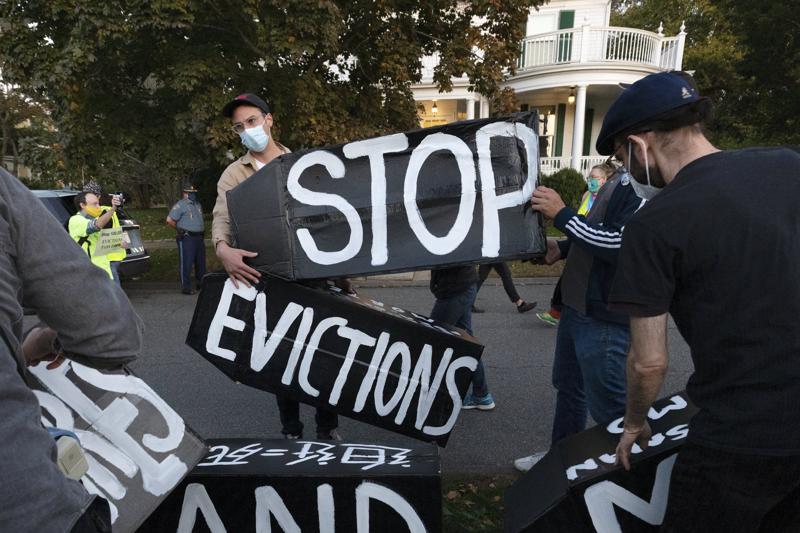
SIOUX FALLS, S.D. (AP) — A federal freeze on most evictions that was enacted last year is scheduled to expire Saturday, after the Biden administration extended the original date by a month. The moratorium put in place by the Centers for Disease Control and Prevention in September has been the only tool keeping millions of tenants in their homes. Many of them lost jobs during the coronavirus pandemic and have fallen months behind on their rent.
Landlords successfully challenged the order in court, arguing that they also had bills to pay. They pointed out that tenants could access nearly $47 billion in federal money set aside to help pay rents and related expenses.
Advocates for tenants said the distribution of the money had been slow and that more time was needed to distribute it and repay landlords. Without an extension, they feared a spike in evictions and lawsuits seeking to oust tenants who were behind on their rents.
Even with the delay, roughly 3.6 million people in the U.S. as of July 5 said they would face eviction within the next two months, according to the U.S. Census Bureau’s Household Pulse Survey. The survey measures the social and economic effects of the pandemic every two weeks through online responses from a representative sample of U.S. households.
Here’s the situation in South Dakota:
WHAT’S THE STATUS OF EVICTION MORATORIUMS IN THE STATE?
South Dakota did not enact its own moratorium on evictions, so when the CDC’s expires, thousands of renters will lose their protection.
WHAT’S BEING DONE TO HELP PEOPLE FACING EVICTION?
South Dakota has received $360 million in federal funds to help tenants with outstanding rent, utility payments and other expenses. The money can go toward 15 months of rent and other expenses, including internet access. Renters who pay 30% of their income toward rent and earn 80% or less of their area’s median income qualify.
So far, only a small fraction of the funds have been sent to renters. The South Dakota Housing Development Authority, which oversees the money, estimates that it has distributed about $12 million to 1,903 tenants.
“There’s a large population that isn’t aware this assistance exists,” said Brent Thompson, the executive director of East River Legal Services, a legal clinic that aids renters facing evictions and that is one of several local groups working with the Housing Development Authority to make renters facing eviction aware of the assistance.
HOW ARE THE COURTS HANDLING EVICTION ACTIONS?
During the moratorium, courts had halted many eviction actions or landlords have decided not to file them. But Thompson said that is changing.
The East River Legal Services clinic has seen a 50% increase in people facing evictions since May. The clinic is now handling at least one case a day, Thompson said, adding he feared the situation will only worsen.
“We are expecting a tsunami of eviction actions,” he said.
According to the state court system, evictions decreased by about 10% after the pandemic started in March 2020. This year, evictions filings have been even lower, decreasing by about 22% from pre-pandemic levels.
HOW AFFORDABLE ARE THE STATE’S MAJOR RENTAL MARKETS?
South Dakota’s rental housing market has tightened, partly due to the strong economy and a shortage of affordable housing. From 2015 through 2020, rent for a two-bedroom apartment in Sioux Falls, the state’s largest city, increased by 17%, according to the U.S. Department of Housing and Urban Development. The state’s vacancy rate was about 7% before the pandemic, which roughly matched the national average.
Statistics on rental housing during the pandemic haven’t been released yet. But lawmakers have sounded the alarm about a run on affordable housing and formed a special committee to try to find solutions to the problem. Republican state Rep. Roger Chase, who also works as a realtor, said recently that the housing market was as tight as he had seen in more than 30 years.
ARE EVICTIONS EXPECTED TO CREATE A SURGE IN HOMELESSNESS?
It’s hard to say how much homelessness will increase in South Dakota. Thompson, of East River Legal Services, expects evictions and eviction-related lawsuits to spike after the CDC’s moratorium ends. One indication of the scope of the problem is census data estimating that there are over 13,500 adults in the state who are fear they will be evicted in the next two months.
Thompson feared the moratorium’s end would create a “crisis event” in evictions, and his legal clinic is bracing for a surge in people facing evictions or owing multiple months of rent.
He is now trying to make judges and court administrators aware of the federal relief in the hopes they can help resolve the cases without ordering an eviction.
